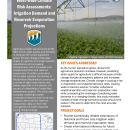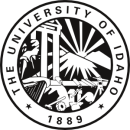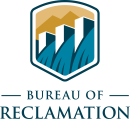Location
States
ColoradoIntroduction
Agricultural water use accounts for 80-90% of the United States’ water supply, and demand continues to rise as the human population grows. Climate change limits water supply through various mechanisms, including increases in evapotranspiration (ET) (i.e., evaporation from soil and from crops), and reservoir evaporation. The increase in evapotranspiration from crops and reservoir evaporation poses management issues as climate change climate change
Climate change includes both global warming driven by human-induced emissions of greenhouse gases and the resulting large-scale shifts in weather patterns. Though there have been previous periods of climatic change, since the mid-20th century humans have had an unprecedented impact on Earth's climate system and caused change on a global scale.
Learn more about climate change causes future water supplies to be unknown.
In order to better understand the future of the water supply, the Bureau of Reclamation (Reclamation) conducted a survey of eight major river basins (Colorado, Columbia, Klamath, Missouri, Rio Grande, Sacramento, San Joaquin, and Carson & Truckee Basins) and twelve reservoirs in the western United States as part of Reclamation’s West-Wide Climate Risk Assessments project. This study used the ET (evapotranspiration) Demands Model & Complementary Relationship of Lake Evaporation Model to provide a better understanding of historical and future crop irrigation demands (based on evapotranspiration) and reservoir evaporation rates throughout the western U.S., as well as to inform management of water resources during climate change.
Key Issues Addressed
As the human population grows, demand for agricultural products increases. However, predicting water supply for agricultural products is difficult because climate change disrupts precipitation patterns and increases average temperatures across the globe, particularly in the western U.S. Increased temperatures and longer, drier droughts also increase evapotranspiration from crops and evaporation from water bodies, further impacting water supply and demand. Evapotranspiration is a major factor affecting water demand for agriculture because evapotranspiration determines the amount of water used by a crop. Therefore, as climate change causes evapotranspiration rates to increase, crops’ water needs increase. Because of the rise in evaporation and evapotranspiration rates from climate change, water becomes more scarce and supply for agricultural products is limited. To better understand evapotranspiration and reservoir evaporation rates while considering the challenge of predicting water demands in a changing climate, this study evaluated multiple climate change scenarios across various time scales in the west to determine the most accurate outlooks.
Project Goals
- Apply widely accepted approach for estimating evapotranspiration and reservoir evaporation
- Provide widely accepted and scientifically reliable estimations of historical and future crop irrigation water demand and reservoir evaporation rates that account for climate changes
- Create informational reference for future studies, assessments, planning efforts and other West-Wide Climate Risk Assessment projects
- Establish a foundation for future water management strategies with state and local partners
Project Highlights
Models for Management: Modeling helps inform water management decisions now, rather than making uninformed decisions in the future, when managers cannot preserve lost resources from climate change.
- Developing Future Climate Scenarios: Researchers developed five climate scenarios based on CMIP3 (World Climate Research Program Coupled Model Intercomparison Project Phase3) climate projections of precipitation and temperature including warm-dry, warm-wet, hot-dry, hot-wet, and a central range of the climate projections (central tendency). Three future periods were used to assess future demands: 2010-2039; 2040-2069; and 2070-2099. Creating climate projections allows the models to predict the irrigation demand and evaporation rates for many years into the future.
- Evapotranspiration and Irrigation (ET) Demands Model:This model predicted crop evapotranspiration and net irrigation water requirements for the future climate scenarios using precipitation and temperature data from over 550 weather stations and networks across the eight major Reclamation basins. The ET Demands Model is based on widely accepted methods of estimating crop evapotranspiration and net irrigation water requirements (the amount of water crops need to grow). This model is more reliable than other models because of its consideration of differing growing seasons across climate scenarios and its more accurate calculation of net irrigation water requirements of specific crops.
- Complementary Relationship of Lake Evaporation (CRLE) Model: The CRLE model predicted historical and future evaporation rates from twelve Reclamation reservoirs and lakes. This model can be more reliable than the traditional pan evaporation method of measuring large water body evaporation, because it accounts for heat storage, while the pan evaporation method does not. This model can utilize limited weather data to overcome limitations associated with other more complex models, making it more practical but reliable.
Lessons Learned
This project met its original goals by providing reliable and robust model results that would inform future water management and other projects. The models projected an increase in temperature by 2.8°C (5°F) over the 90-year period for all basins. Crop evapotranspiration is also projected to increase for perennial crops, but with variable increases or decreases for annual crops. Reservoir evaporation is projected to increase, as a function of increasing temperatures, limiting the water supply. However, many factors of evaporation and water demand are highly variable and basin dependent, including precipitation. Furthermore, temperature estimates are more certain than precipitation estimates, and estimations of crop irrigation demands and reservoir evaporation for nearer future time periods are more certain than further future time periods.
Building the ET Demands Model posed significant challenges for this project. This model was originally developed by the University of Idaho, Idaho Department of Water Resources, Nevada Division of Water Resources, and Desert Research Institute for Idaho’s climate. Thus, the model developers added parameters so the model could be applied to all basins being assessed. These modifications to the model and the extensive calibration required ultimately extended the project several years beyond schedule. However, this work provided solid model results. In order to overcome challenges, a more realistic schedule and budget would have been more appropriate for developing the models.
Though the model results are substantial, there are several methods that would have provided a more comprehensive assessment. The most recent 231 downscaled and bias-corrected CMIP5 climate projections became available during the course of the study, but the condensed CMIP3 projections had to be used because of budget and schedule constraints. The use of a finer resolution of model inputs (e.g., 2-kilometer gridded), compared to the use of the HUC8 spatial scale in this study, would have produced more comprehensive model results. Overall, the model results provided a solid baseline for future projects and water management.
Next Steps
- Conduct another run of the models using the most recent climate projections and more higher-resolution climate scenarios
- Apply information learned from this risk assessment with more advanced instrumentation in the field to improve future risk assessments
- Use information from this risk assessment to inform water and drought management of water bodies across the U.S.
Funding Partners
Bureau of Reclamation WaterSMART Program
Resources
Irrigation Demand Projections StoryMap
Contacts
Mark Spears, Hydraulic Engineer, Bureau of Reclamation: jspears@usbr.gov
Case Study Lead Authors
- Nicole Williams, CCAST Student Writer, University of Arizona
- Mark Spears, Hydraulic Engineer, Bureau of Reclamation: jspears@usbr.gov
Suggested Citation
Williams, N. and Spears, M. (2021). “West-Wide Climate Risk Assessments: Irrigation Demand and Reservoir Evaporation Projections.” CCAST. Retrieved from https://www.fws.gov/project/west-wide-climate-risk-assessments-irrigation-demand-and-reservoir-evaporation.







